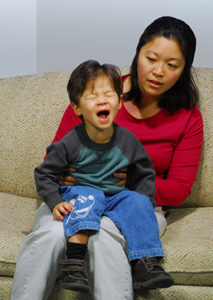Adam, aged 2, was playing with his new ball. He suddenly tripped while playing and bumped his head on the ground. He got up and started to cry out loud in pain. His mother quickly came and tried to console him. Out of the sudden, he stopped breathing, his face turned blue for a couple of seconds and he passed out. About 1 minute later, his face turned pink and he was breathing again.
What is wrong with Adam? Has it happened to your child before? What Adam is having is called a ‘Breath holding spell’.
What is breath holding spells?

Sumber gambar: Sterling Care
Breath holding spell is a brief episode of passing out when a child cries when triggered by pain, fright, anger or being upset. It usually happens to children aged 6 months to 4 years old. Each episode usually last less than one minute. It is involuntarily which means that the child is not aware and not in control of the attacks. When this happens, it could be rather frightening for parents to handle. Parents might think that the child is having a fit or seizure. These episodes can happen several times a day or even once a year. The frequency of spells is reduced and completely gone as the child grows up.
Types of breath holding spells
There are two types of breath holding attack. They are the cyanotic type and the pallid type. The cyanotic type usually causes the child to turn blue especially around the lips and it is more common. For the pallid type, the child becomes pale rather than turning blue.
What happens during a breath holding spells?
The actual cause for it is still unclear. When a child cries after a triggering factor, he will then make no sound even though he will look as if he is still crying. During this episode, the child cries and at the same time is breathing (exhaling) out the air in the lungs. This will trigger the autonomic nervous system of the body to respond causing the heart rate and blood pressure to decrease, thus making child to become blue and when the blood does go into the brain, the child will pass out. Even though it happens less than one minute, the child will usually feel sleepy after an attack.
When should I be worried?
If your child experiences these episodes, it is better for you to take them to see a doctor. A detailed history and thorough examination will be done in order to ensure serious diseases are ruled out. Other illnesses that need to be ruled out are epileptic seizure and cardiac problem. Usually during these spells, there are no other accompanying symptoms or abnormal movements such as fever, jerky limb movements or up-rolling of eyeball.
If my child is diagnosed with breath holding spells, what should I do?
After a thorough and detailed history taking, physical examination and at times some investigation done, your doctor will tell you that your child might be having a breath holding spells or attacks. So, what do you need to do if the attacks happened again? The first step is to stay calm since breath -holding spells are usually brief.
Keep an eye on your child until the spell or attack is over. Try to lie him/her on his/her side and keep him/her away from any injury. Do not put anything into the mouth or give mouth-to-mouth resuscitation. Your child will breath on his/her own once the spell is over. Once the spell is over, do not scold or punish your child. Breath-holding spells are not harmful and pose no long-term risks for the child.
Can I prevent breath-holding spells?
Sometimes as a parent you can tell when is your child is about to experience those spell or attack. You should try to avoid most of the triggers that causes the child to cry and try distracting your child if he/she displays certain behaviours prior to the spells.
In summary, breath-holding spells are common in childhood and can be dramatic. However, it rarely is life-threatening and usually will outgrow as the child grows up. Whenever in doubt, do not hesitate to bring your child to see a doctor for evaluation.
References:
1.Goldman, R. D. (2015). Breath-holding spells in infants. Canadian Family Physician, 61(2), 149–150.
2.Geetanjali Rathore, Paul Larsen, Cristina Fernandez, and Manish Parakh, 2013. Diverse Presentation of Breath Holding Spells: Two Case Reports with Literature Review Case Reports in Neurological Medicine, vol. 2013, Article ID 603190, 3 pages, 2013.
This article was written by:
Dr Nurjasmine Aida Jamani
Family Medicine Specialist/Medical Lecturer/IBCLC
[This article belongs to The Malaysian Medical Gazette. Any republication (online or offline) without written permission from The Malaysian Medical Gazette is prohibited.]
